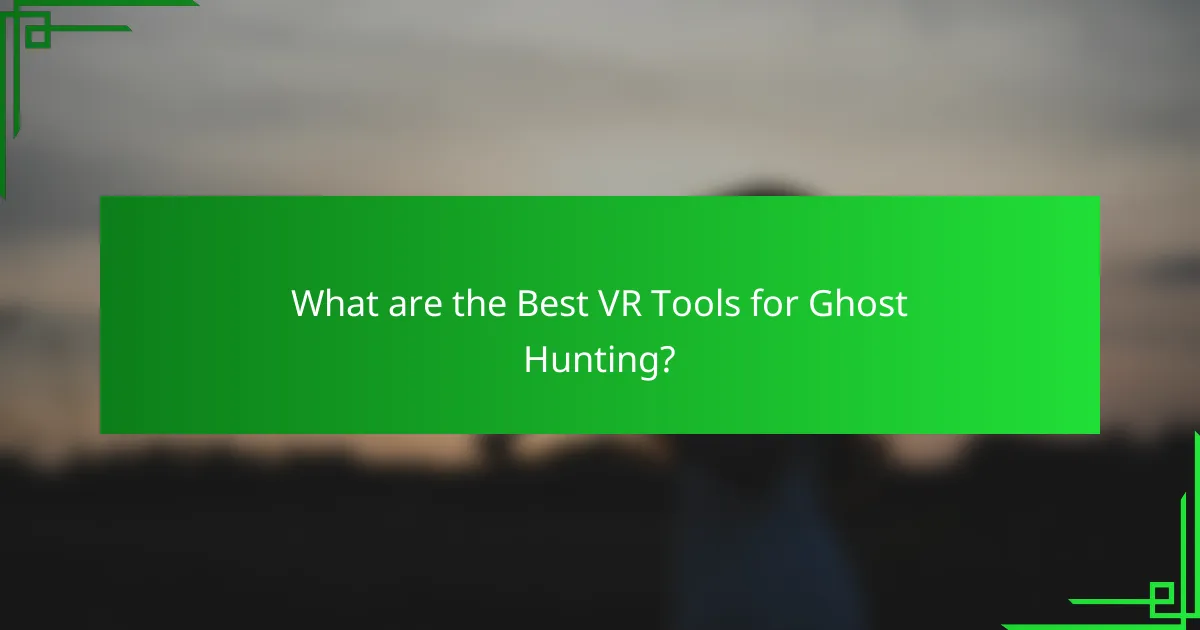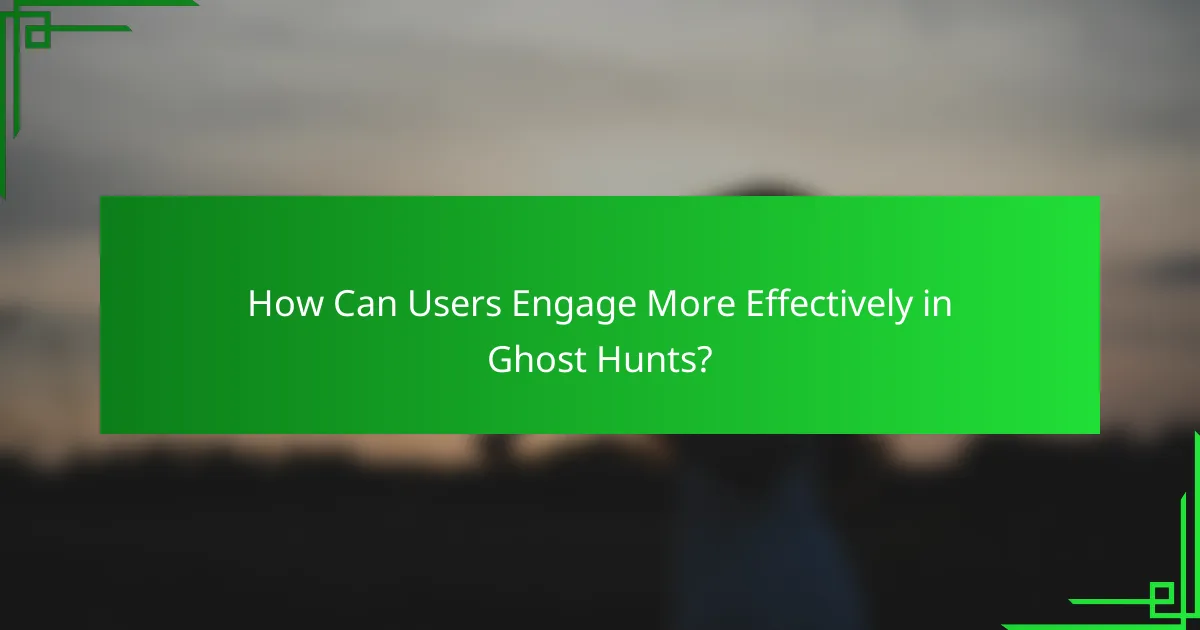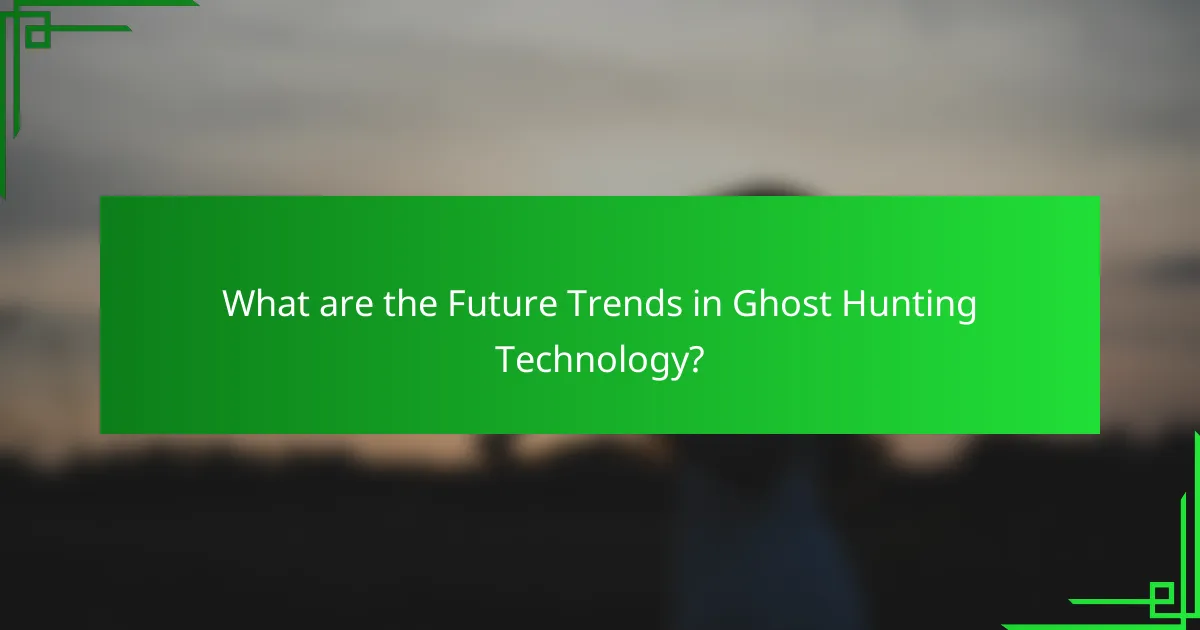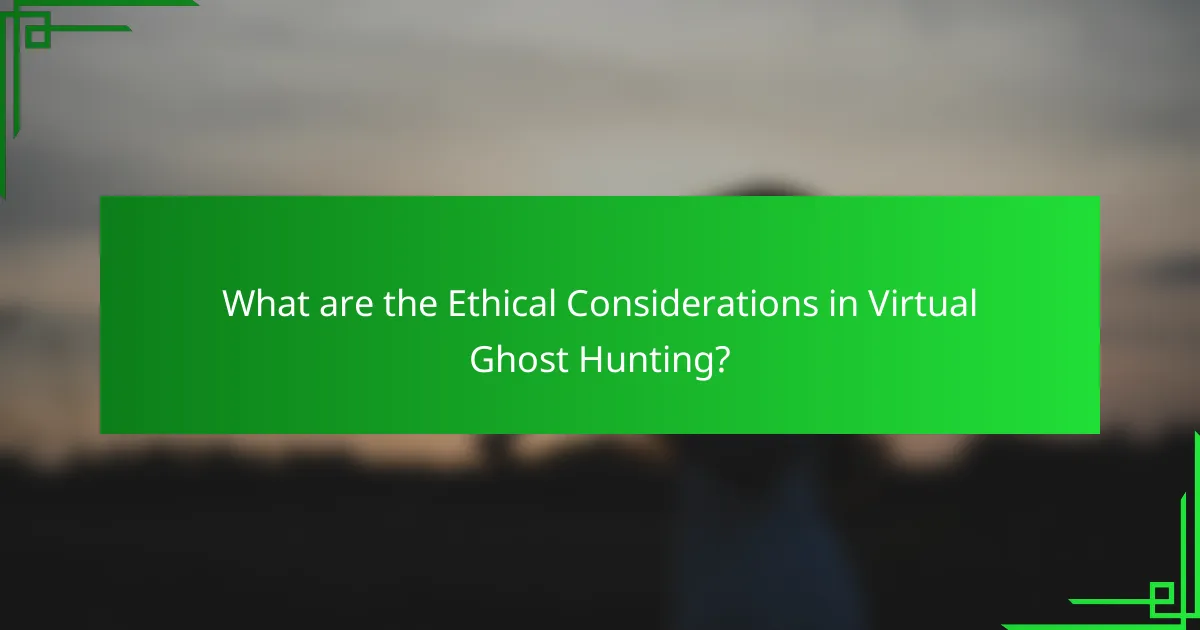The future of ghost hunting is being transformed by virtual reality (VR), which offers immersive experiences that enable users to explore haunted locations without the limitations of physical presence. This innovative technology not only enhances user engagement but also makes paranormal investigations more accessible and exciting. By leveraging advanced VR tools and interactive platforms, enthusiasts can collaborate in real-time, deepening their connection to the supernatural world.

How is Virtual Reality Transforming Ghost Hunting?
Virtual reality (VR) is revolutionizing ghost hunting by providing immersive experiences that allow users to explore haunted locations without physical constraints. This technology enhances engagement and interaction, making the paranormal investigation more accessible and thrilling.
Enhanced Immersion Experiences
Enhanced immersion experiences in ghost hunting allow users to feel as though they are truly present in haunted environments. VR technology creates realistic soundscapes and visuals that can evoke strong emotional responses, making the experience more intense.
Users can interact with their surroundings in ways that traditional ghost hunting cannot offer. For instance, they can manipulate objects, communicate with virtual entities, or even participate in guided investigations, all while feeling physically present in the scene.
Realistic Environments with Oculus Quest
The Oculus Quest provides a platform for creating highly realistic ghost hunting environments. With its advanced graphics and spatial audio capabilities, users can explore detailed recreations of haunted houses, abandoned asylums, or eerie forests.
This device allows for wireless movement, enabling users to walk around and investigate their surroundings freely. The immersive nature of the Oculus Quest enhances the thrill of ghost hunting, as users can experience the fear and excitement of potential paranormal encounters firsthand.
Interactive Ghost Hunting with Paranormal Activity VR
Paranormal Activity VR offers an interactive ghost hunting experience that combines gameplay with real-world ghost hunting techniques. Users can utilize tools like EMF meters and spirit boxes within the VR environment to engage with virtual spirits.
This interactive approach encourages users to apply their ghost hunting knowledge while navigating through various scenarios. Players can collaborate with friends or other users online, enhancing the social aspect of ghost hunting and making it a shared adventure.

What are the Best VR Tools for Ghost Hunting?
The best VR tools for ghost hunting combine immersive technology with user engagement, allowing enthusiasts to explore haunted locations virtually. Key options include the HTC Vive Pro, PlayStation VR, and specialized games like Ghostbusters VR, each offering unique features suited for different user needs.
HTC Vive Pro for High Fidelity
The HTC Vive Pro is renowned for its high-fidelity graphics and immersive audio, making it an excellent choice for serious ghost hunters. With a resolution of around 2880 x 1600, it provides stunning visuals that enhance the experience of exploring haunted environments.
Consider the Vive Pro’s tracking capabilities, which utilize external base stations for precise movement detection. This feature allows users to navigate large spaces, making it ideal for simulating real-life ghost hunting scenarios. However, ensure you have a powerful PC to support its demanding requirements.
PlayStation VR for Accessibility
PlayStation VR offers a more accessible entry point for ghost hunting enthusiasts, particularly for those who already own a PlayStation console. Its user-friendly setup and lower price point make it appealing for casual users looking to explore the paranormal.
While the graphics may not match the HTC Vive Pro, PlayStation VR still delivers engaging experiences with a variety of ghost hunting games. Users should be aware that the tracking is less precise, which may affect the overall immersion during exploration.
Ghostbusters VR for Engaging Gameplay
Ghostbusters VR stands out for its engaging gameplay, allowing players to step into the shoes of a ghostbuster in a fun and interactive environment. This game combines humor with action, making it suitable for both casual players and dedicated ghost hunting fans.
With its cooperative multiplayer mode, Ghostbusters VR encourages teamwork, allowing friends to join in on the ghost-hunting adventure. While it may not provide the same level of realism as other tools, its entertaining approach can be a great way to introduce newcomers to the world of virtual ghost hunting.

How Can Users Engage More Effectively in Ghost Hunts?
Users can engage more effectively in ghost hunts by leveraging technology and community features that enhance the experience. Utilizing interactive apps and platforms allows for deeper immersion and real-time collaboration with fellow enthusiasts.
Community Features in Ghost Hunting Apps
Community features in ghost hunting apps foster collaboration and shared experiences among users. These features often include forums, chat rooms, and event calendars where users can discuss findings, share tips, and organize group hunts.
Many apps also allow users to create profiles, track their ghost hunting history, and share their experiences through photos and videos. This not only builds a sense of belonging but also encourages users to participate more actively in the ghost hunting community.
Live Streaming with Twitch for Real-Time Interaction
Live streaming on platforms like Twitch enables ghost hunters to share their experiences in real-time, allowing viewers to interact and engage during the hunt. This format creates a dynamic environment where viewers can ask questions, provide suggestions, and react to events as they unfold.
To maximize engagement, streamers should interact with their audience frequently, responding to comments and incorporating viewer suggestions into their ghost hunting strategies. This not only enhances the viewing experience but also builds a loyal following of engaged fans.

What are the Future Trends in Ghost Hunting Technology?
The future of ghost hunting technology is set to evolve significantly with advancements in virtual reality, artificial intelligence, and augmented reality. These trends promise to enhance user engagement and provide deeper insights into paranormal investigations.
AI Integration for Enhanced Analysis
AI integration in ghost hunting technology focuses on improving data analysis and interpretation. By utilizing machine learning algorithms, investigators can analyze audio and visual data more effectively, identifying patterns that may indicate paranormal activity.
For instance, AI can sift through hours of recorded audio to detect anomalies or unusual frequencies that human ears might miss. This technology can also help in categorizing and prioritizing evidence, allowing ghost hunters to focus on the most compelling findings.
Augmented Reality Experiences
Augmented reality (AR) is transforming ghost hunting by overlaying digital information onto the real world. This technology allows users to visualize paranormal activity in real-time, enhancing their experience and engagement during investigations.
For example, AR applications can display historical data about a location, highlight hotspots of reported activity, or even simulate ghostly apparitions. This immersive approach not only makes investigations more interactive but also educates users about the history and context of the sites they explore.

How Do User Experiences Shape Ghost Hunting?
User experiences significantly influence the evolution of ghost hunting, particularly through the integration of technology like virtual reality (VR). Engaging users in immersive environments enhances their emotional connection and overall enjoyment, leading to more memorable experiences.
User Feedback on VR Platforms
User feedback is crucial for the development of VR platforms in ghost hunting. Participants often share insights on the realism of environments, the effectiveness of ghost detection tools, and the overall engagement level. This feedback helps developers refine experiences to better meet user expectations.
For instance, many users appreciate interactive elements that allow them to manipulate objects or communicate with virtual entities. Incorporating these features can significantly enhance user satisfaction and retention.
Case Studies of Successful Ghost Hunts
Several case studies illustrate the successful application of VR in ghost hunting. One notable example involved a team that used VR to recreate a historically haunted location, allowing users to explore the site from home. This approach not only attracted a wider audience but also generated positive reviews for its immersive experience.
Another case study highlighted a live-streamed ghost hunt where viewers could influence the direction of the investigation through real-time voting. This interactive format kept users engaged and created a sense of community among participants, demonstrating the potential for user-driven experiences in ghost hunting.

What are the Ethical Considerations in Virtual Ghost Hunting?
Ethical considerations in virtual ghost hunting revolve around the respect for historical sites and the privacy of user data. As technology advances, it is crucial to ensure that immersive experiences do not compromise the integrity of locations or the confidentiality of participants.
Respecting Historical Sites
Virtual ghost hunting often involves exploring historical sites, which can be sensitive locations. It is essential to obtain permission from site owners and adhere to local regulations regarding access and preservation. Engaging with these sites responsibly helps maintain their historical significance and prevents potential damage.
Additionally, virtual experiences should accurately represent the history and culture of the sites. Misrepresentation can lead to misinformation and disrespect towards the heritage of the location. Collaborating with historians or local communities can enhance the authenticity of the experience.
Privacy Concerns with User Data
User privacy is a significant ethical concern in virtual ghost hunting. Many platforms collect personal data to enhance user engagement, but this data must be handled with care. Clear privacy policies should be established, outlining how data is collected, stored, and used.
Users should be informed about their rights regarding their data, including options to opt-out or delete their information. Implementing strong data protection measures can help build trust with users and ensure compliance with regulations such as the General Data Protection Regulation (GDPR) in Europe.
